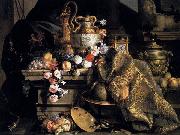Wholesale Oil Painting No Minimum |
|||||||||||
|
|
|||||||||||

|
|||||||||||
|
|
|
||||||||
Jean-Baptiste Monnoyer(12 January 1636 - 20 February 1699) was a Franco-Flemish painter who specialised in flower pieces. He was attached to the Gobelins tapestry workshops and the Beauvais tapestry workshops, too, where he produced cartoons of fruit and flowers for the tapestry-weavers, and at Beauvais was one of three painterswho collaborated to produce cartoons for the suite The Emperor of China. He was born at Lille, but was in Paris by 1650, where he was documented working on the decors of the Hôtel Lambert. He was taken up by Charles Le Brun for decorative painting at the Château de Marly and at the Grand Dauphin's residence, the Château de Meudon. He was received at the Academie Royale de Peinture et de Sculpture in 1665 with a piece of the genre that he made his specialty, a still life of flowers and fruit combined with objets d'art. His only appearance at the Paris salon was in 1673. |
||||||||
|
|
||||||||
Flowers and Fruits
Flowers and Fruits Painting ID:: 76812 |
Date 1665
Medium Oil on canvas
Dimensions 146 x 190 cm
cyf Date 1665 Medium Oil on canvas Dimensions 146 x 190 cm cyf |
|||||||
|
|
||||||||
|
Zygmunt Waliszewski (1897-1936) was a Polish painter, a member of the Kapist movement. Waliszewski was born in Saint Petersburg to the Polish family of an engineer. In 1907 his parents moved to Tbilisi where Waliszewski spent his childhood. In Tbilisi began his studies at a prestigious art school. In 1908 he had his first exhibition and participated in the life of artistic avant-garde. During World War I he fought with the Russian army, returning to Tbilisi in 1917. He visited Moscow several times and became inspired by the Russian Futurists. He, later, became a member of a Futurist group. In the early 1920s, he departed for Poland, and settled in Krakew. Between 1921 and 1924 he studied at Academy of Fine Arts in Krakew in the studios of Wojciech Weiss and Jezef Pankiewicz. In 1924 he went to Paris with his avante-garde group and continued his studies in painting there under the guidance of Pankiewicz. He was a participant in the Capists' plein-air painting workshops in Cagnes, Valence, Cap Martin, and Avignon. At the Louvre, he painted copies and travesties of the works of old masters like Titian, Veronese, Velezquez, Vermeer, Goya, and Delacroix. He was also fascinated by the art of Cezanne, van Gogh, and Matisse. In 1931 he returned to Poland, residing in Warsaw, Krzeszowice, and Krakew. During this time Waliszewski designed scenery and posters, created book illustrations, drew and painted caricatures and grotesque scenes. In Krakew he befriended the Polish Formists. Waliszewski painted primarily portraits and figural compositions and landscapes of the rural countryside. He died suddenly in 1936. Flowers and fruits Date 1932 TTD |
||||||||
|
|
||||||||
|
Prev Next
|
||||||||
|
|
||||||||
|
Related Paintings to Zygmunt Waliszewski :. |
||||||||
|
|
||||||||
|
CONTACT US |

